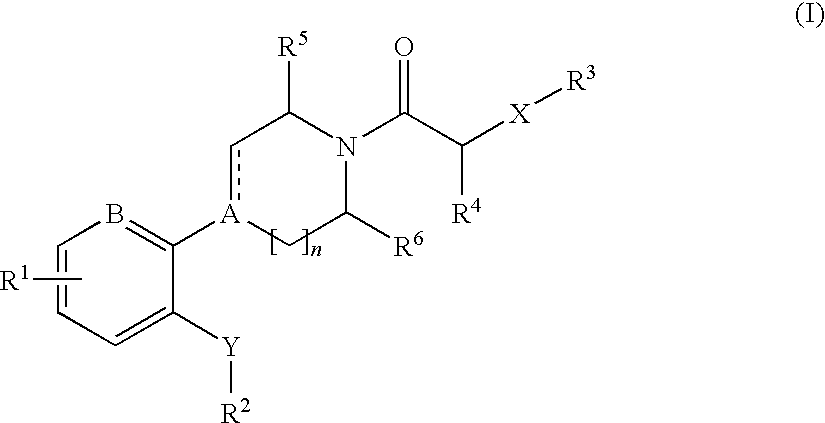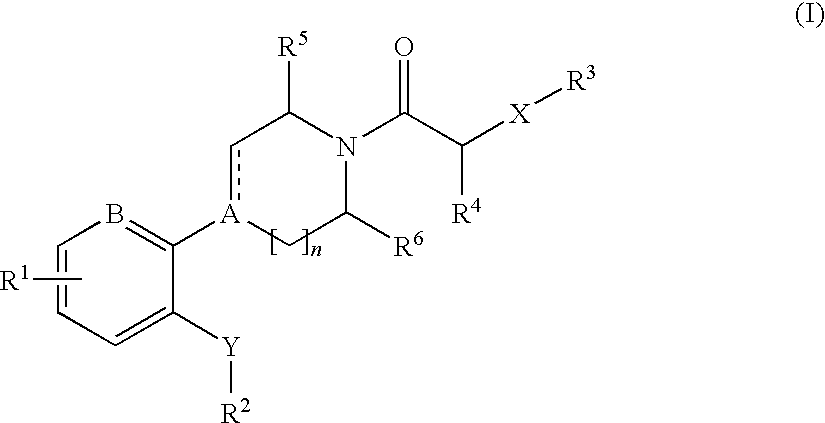Cxcr3 receptor antagonists
- Summary
- Abstract
- Description
- Claims
- Application Information
AI Technical Summary
Benefits of technology
Problems solved by technology
Method used
Image
Examples
example 1
Synthesis of 2-{4-[2-(3,5-dimethyl-pyrazol-1-yl)-acetyl]-piperazin-1-yl}-N-phenyl-benzamide
[0303]
[0304]2-Piperazin-1-yl-benzoic acid (2.000 g, 9.79 mmol) is suspended in 100 mL of CH2Cl2. To this is added diisopropylethyl amine (2.22 mL, 12.00 mmol) and BOC anhydride (2.07 g, 9.50 mmol). After 1 hour, an additional 100 mL of anhydrous CH3CN is added and the mixture is stirred overnight. The mixture is diluted with 250 mL of EtOAc, followed by 250 mL of sat. NH4Cl. The organic phase is washed with 2×250 mL of H2O and 1×250 mL of brine. The organic phase is dried with MgSO4, filtered and concentrated to give 2.37 g of 4-(2-carboxy-phenyl)-piperazine-1-carboxylic acid tert-butyl ester, 80% yield.
[0305]An alternative method for preparing this intermediate is as follows. 4-(2-Formyl-phenyl)-piperazine-1-carboxylic acid tert-butyl ester (0.50 g, 1.72 mmol) is dissolved in 80 mL of dioxane and 20 mL of H2O. The mixture is cooled to 4° C. To this is added sulfamic acid (1.36 g, 14.00 mmol) ...
example 2
Synthesis of 2-{4-[2-(3,5-Dimethyl-pyrazol-1-yl)-acetyl]-piperazin-1-yl}-N-pyridin-4-yl-benzamide
[0416]
[0417]2-Piperazin-1-yl-benzoic acid (1.000 g, 4.89 mmol) is suspended in 10 mL of MeOH. To this is added 5 mL of conc. H2SO4. The mixture is stirred for 16 h resulting in a white precipitate. An additional 5 mL of H2SO4 is added with an additional 10 mL of MeOH. The reaction volume is increased by an additional 200 mL of MeOH and 60 mL of H2SO4 and the mixture is stirred an additional 2 h and then heated at reflux for 12 h. The reaction volume is then reduced to approximately 175 mL and applied to an ion exchange column, eluting with 5×200 mL of 10% NH3 / MeOH and then the product fractions are concentrated. The eluent is co-evaporated with toluene to remove residual water to give 0.667 g of 2-piperazin-1-yl-benzoic acid methyl ester in 63% yield.
[0418]To a vial containing the 2-piperazin-1-yl-benzoic acid methyl ester (0.667 g, 3.03 mmol) is added a pre-mixed solution containing (3,...
example 3
Synthesis of 2-{4-[2-(2,4-Dimethyl-imidazol-1-yl)-acetyl]-piperazin-1-yl}-N-phenyl-benzamide
[0453]
[0454]To a vial containing 4-(2-phenylcarbamoyl-phenyl)-piperazine-1-carboxylic acid tert-butyl ester (0.438 g, 1.150 mmol) is added 2 mL of CH2Cl2 and 2 mL of TFA. The mixture stirred for 1 h and then concentrated to dryness to give 0.454 g of 4-(2-phenylcarbamoyl-phenyl)-piperazine trifluroacetate in 100% yield.
[0455]4-(2-phenylcarbamoyl-phenyl)-piperazine trifluroacetate (0.454 g, 1.150 mmol) is dissolved in 10 mL of CH2Cl2 containing diisopropylethyl amine (0.554 mL, 3.000 mmol). The mixture is cooled to 4° C. and chloroacetyl chloride (0.105 mL, 0.130 mmol) is added in a dropwise fashion. The reaction is stirred for 2 h in ice bath and then quenched with 20 mL of saturated NH4Cl. The reaction is diluted with 100 mL EtOAc and washed with 2×20 mL of H2O and 1×20 mL of brine. The organic phase is dried with MgSO4, filtered and concentrated. The crude product is purified via a SiO2 col...
PUM
| Property | Measurement | Unit |
|---|---|---|
| Volume | aaaaa | aaaaa |
Abstract
Description
Claims
Application Information
 Login to View More
Login to View More - R&D
- Intellectual Property
- Life Sciences
- Materials
- Tech Scout
- Unparalleled Data Quality
- Higher Quality Content
- 60% Fewer Hallucinations
Browse by: Latest US Patents, China's latest patents, Technical Efficacy Thesaurus, Application Domain, Technology Topic, Popular Technical Reports.
© 2025 PatSnap. All rights reserved.Legal|Privacy policy|Modern Slavery Act Transparency Statement|Sitemap|About US| Contact US: help@patsnap.com



